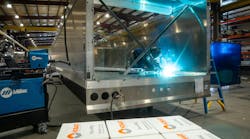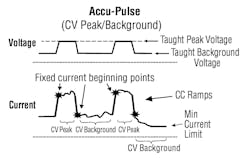Aluminum is a critical material in trailer manufacturing, prized for its excellent weight-to-strength ratio and corrosion-resistant properties. Despite these advantages, welding aluminum presents unique challenges. This article, prepared for Trailer-Body Builders by the welding experts at Miller Electric Mfg. LLC, delves into the specifics of aluminum welding for trailers, addressing common pitfalls and emphasizing the importance of preparation, filler metal selection and advanced welding equipment to optimize performance and productivity.
Aluminum’s role
Aluminum is indispensable in the commercial trailer segment, utilized for flooring, structural components, sidewalls and tanks. Its lightweight nature reduces overall trailer weight, increasing payload capacity and fuel efficiency.
Additionally, aluminum’s natural corrosion resistance makes trailers more durable and easier to maintain, as the material withstands harsh weather conditions without rusting. Aluminum’s inherent strength and flexibility also enable it to endure strains and stresses during operation, making it ideal for heavy-duty use.
However, aluminum’s high thermal conductivity and low melting point introduce significant complexity in welding. These properties increase the likelihood of heat-related issues, such as warping or burn-through, and necessitate precise welding techniques.
Overcoming common pitfalls
Welding aluminum requires addressing several challenges to ensure strong, defect-free welds.
- Joint Preparation: Proper joint preparation is vital for a successful weld. Contaminants such as grease, oil and oxidation must be removed using a solvent and a stainless-steel brush. Aluminum’s naturally occurring oxide layer, which melts at a much higher temperature than the base metal, can cause fusion issues and porosity if not properly cleaned.
- Feed ability: Feeding filler metal during GMAW (MIG) welding is a common challenge due to aluminum’s softness. Push-pull guns are effective in mitigating feed issues, although they add complexity to the system. Using a larger wire diameter and ensuring proper cable management, such as avoiding loops and tangles in the MIG lead, are also critical to achieving consistent feed performance.
- Cracking: Heat management is essential to prevent cracking, especially in thicker aluminum sections. Excessive heat input or rapid cooling can compromise weld integrity, leading to failure and non-compliance with welding codes. Selecting appropriate filler material and designing joints with reduced stress concentration are critical strategies to minimize cracking and ensure long-term durability.
- Puddle Control: Maintaining control of the weld puddle is essential for precision and consistency. The puddle should be small and focused to minimize heat input and prevent excessive melting. Welders must also manage travel speed carefully, maintaining a consistent pace to ensure proper penetration and avoid defects.
Selecting filler metal
Choosing the appropriate filler metal is paramount for achieving strong, aesthetically pleasing welds.
The filler metal’s alloy composition must be compatible with the base metal to avoid cracking or failure. Popular aluminum alloys in trailer manufacturing include:
- 5356: Known for its high strength and ductility, ideal for structural applications.
- 4043: Valued for its corrosion resistance and excellent bead appearance.
For enhanced performance, some manufacturers offer specialized solutions. For example, Hobart MaxalTig 4943 and Hobart MaxalMig 4943 combine the strength of 5356 with the weldability of 4043. These options provide a balanced solution for various trailer applications. Selecting the correct filler diameter based on the material thickness further ensures optimal performance.
Leveraging pulsed welding
Pulsed welding is a specialized technique that helps address common challenges in aluminum welding while boosting productivity and reducing costs. By alternating between high- and low-current pulses, this technology minimizes heat input and improves weld quality.
- Reducing Heat Input: Pulsed welding allows precise control over heat input, reducing the risk of distortion and cracking. This technique is particularly effective for thinner materials, enabling the use of larger diameter wires that can increase travel speeds, which reduces heat input.
- Improved Weld Quality: Pulsed current helps break up the oxide layer on aluminum, promoting better fusion and reducing porosity. Advanced pulsed welding machines can be programmed to match your specific material, gas and filler metal requirements, allowing the machine to automatically adjust based on position of contact tip to work distance, travel angle, travel speed, etc., further enhancing weld quality.
- Versatility: Pulsed welding is effective across various alloys and thicknesses. It is particularly advantageous for out-of-position and thinner base material welding, making it a versatile solution for trailer manufacturers.
Dual wire feed benefits
In multi-material operations, the need to switch between different wire types can introduce inefficiencies. Dual wire feed systems address this challenge by enabling seamless transitions without the need to change spools. Systems like the Deltaweld from Miller Electric offer several advantages:
- Enhanced Flexibility: Dual wire feed systems allow operators to switch between materials such as stainless steel and aluminum effortlessly, eliminating interruptions and boosting productivity.
- Cost Savings: By reducing downtime and material waste, these systems lower overall production costs. Having both wire types available on the same machine eliminates the need for frequent change-outs and additional welding machines, further optimizing resources.
Optimizing aluminum welding
Welding aluminum for trailers requires a thorough understanding of material properties and the application of specialized techniques. By addressing challenges such as joint preparation, feed ability, cracking and filler metal selection, manufacturers can improve weld quality and productivity. Advanced technologies like pulsed welding and dual wire feed systems simplify operations, minimize defects and enhance efficiency.
Embracing these innovations not only addresses the complexities of aluminum welding but also positions trailer manufacturers for long-term success in a competitive market. With the right tools and techniques, manufacturers can achieve high-quality, durable welds that meet the demands of modern trailer production.
Additional Resources: Hobart’s Advanced Aluminum Seminar provides in-depth knowledge on aluminum alloys, welding processes, weld design, procedure development, troubleshooting and quality control, equipping attendees for aluminum welding success. Contact [email protected] for more information and the 2025 course schedule.










